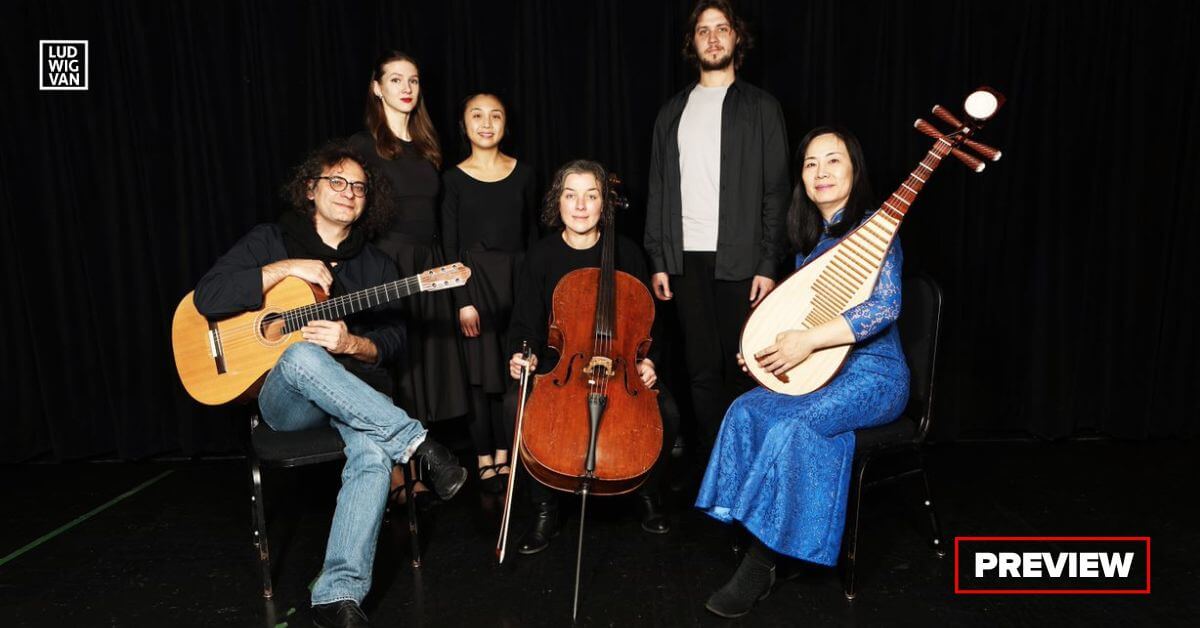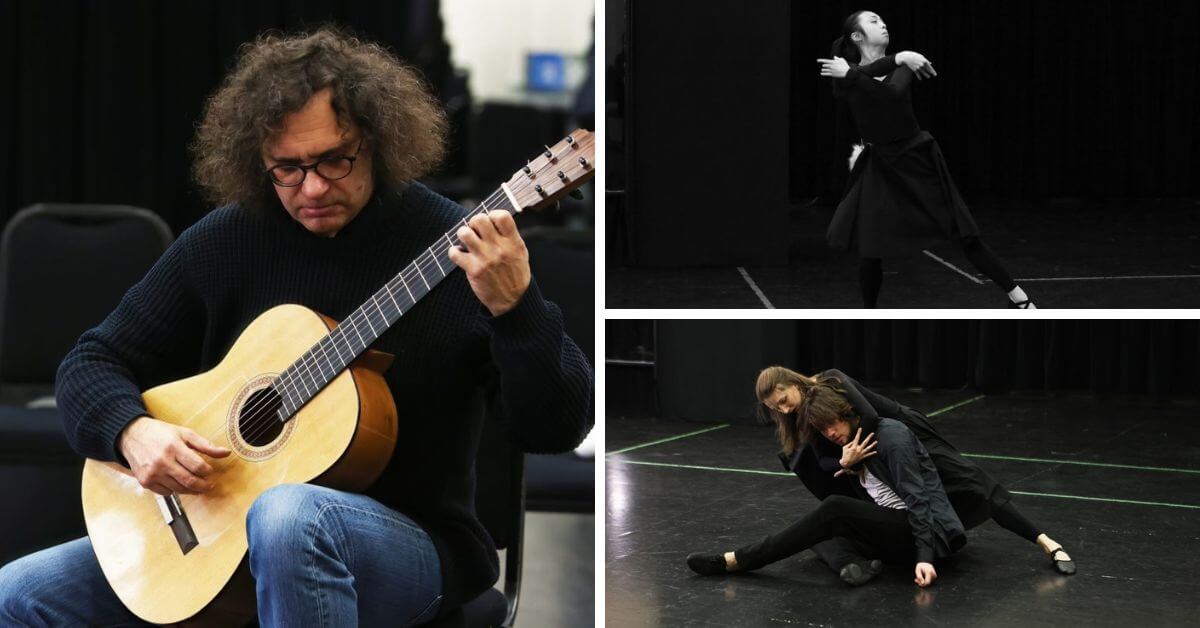
Presented by NP Entertainment, The Legend of Huli will be on stage in Toronto January 20 and 21. Based on a Chinese folk legend, the production tells the story in music and dance.
Guitarist/composer and artistic director Roman Smirnov has constructed a musical performance about a mischievous fox from Asian folklore that incorporates a range of influences.
The Legend of Huli
The story is based on ancient Chinese legends of the Celestial Fox, as collected by philosopher Pu Songling (1640-1715). The Celestial Fox descends to Earth, and stirs up a swirl of trouble when she does.
Musically, contemporary classical music, global beats, jazz, baroque and flamenco blend together in Smirnov’s original compositions. He’s also made arrangements of some traditional Chinese folk songs for the project.
Along with Smirnov on guitar, performers include pipa virtuoso Wen Zhao, Zhenya Kobylyanska on the cello, and dancers Roman Nesterov, Karolina Nesterova and Hayley Ng. The creative team includes artistic director Roman Smirnov, stage director Alexandre Marine, and choreographer Roman Nesterov. Roman Nesterov and Karolina Nesterova were formerly dancers with the Mariinsky Theatre in St. Petersburg, and cellist Zhenya Kobylyanska has previously performed with the National Academic Theatre of Opera and Ballet, Odessa.
Producer Nina Zaslavsky talks about director Alexandre Marin’s concept for the show in a statement. “Every earthly woman possesses the magical gift of the Fox. From time to time, these women tap into this gift to aid in their endeavours. However, should this gift be used for nefarious ends, it threatens not just the loss of the gift but the woman’s very existence.”
Roman Smirnov: The Q&A
How did this show come together? (There is often a good story in how a project takes shape.)
I have been a creator and performer of my own music for quite some time, both solo and in various musical ensembles. My numerous musician friends also perform pieces reflecting their ethnicity, both original compositions and covers, and I often attend their concerts.
It’s no secret that for a great part of my audiences, seeing strong visual images helps them accept and understand music that is new and perhaps unfamiliar. I wanted my friends and other people to have a hard time falling asleep at my concerts. That’s how I came up with the idea to add a visual element to enhance the musical performance by involving more of the senses.
When I was growing up in Estonia, there was a very popular musical pantomime theatre directed by Adolf Traks. They gave spectacular performances based on avant-garde music. The plastic means of expressing emotions made the unfamiliar music more accessible, and in the end it was just beautiful!
In today’s music industry, there is a plethora of classical concerts of the highest quality, each often following the same principle. After a while, I realized that this static style of presentation has aged, and to the average viewer, it has become almost boring. Even back when I lived in Estonia, 35 years ago, I came up with the idea of piecing together a visual representation to the musical aspect, which would contribute to the performance.
Meeting Wen (the Pipa virtuoso) more than 10 years ago brought me closer to my dream of bridging together different forms of art. We started by playing traditional Chinese music, to which I tasked myself to incorporate western harmonies and other elements of ethnic music such as Jewish, Flamenco, Arabic music, even jazz and blues. Zhenya (our cellist) and I met through a Toronto Mandolin Orchestra concert at which we both played. I was insanely amazed by her musical talents, and I invited her to join my project. Fortunately, she agreed to join me throughout the project, and I found her a very flexible musician in terms of her wide spanning talents and adaptations.
The ballet dancers were my second-ever time of including visuals with my music. Our first team was a little bit different: Wen, Demetrios, and I were joined by one dancer, David Giller. We gave the premiere last spring, followed by a tour across Estonia, which all turned out very successful.
After I returned, our producer Nina Zaslavsky and I agreed upon a bigger team, collaborating with a prominent theatre director, Alexandre Marine from Montreal. Alexandre wrote a script based on the concept from my first production, except this time for three dancers. After that, I decided to replace the music for it with my original compositions. This change resulted in a call for instruments capable of a long sustain, which is how the cello came to be added.
The idea of this specific story began with me composing a guitar piece called Fox and Gardener on the theme of the ancient Chinese legends of the magical fox. All the additional pieces featured in the show were written roughly at the same time, around two years ago, which is when I initially began thinking about dancers. The first version of the show featured one dancer: David Giller. This show has three ballet dancers: Roman Nesterov and Karolina Nesterova, who moved here from St. Petersburg a few months ago, and Canadian based dancer Hayley Ng.

What is it about the story that inspires you?
This is an absolutely incredible story. In a second-hand bookstore owned by an Estonian friend of mine, I came across a collection of short stories by the Chinese author Pu Songling. There were ancient tales of magical fox-ladies, deadly charming and – through their immortality — terrifying at the same time. These tales involved unfathomable miracles of reincarnations, divine revelations, obsessions, and magic. All of these were performed by foxes, divine and devilish, women and beasts, beauties and warriors.
I read all these incredibly poetic short stories, and the image of the magical Fox inspired melodies in my head. Of course, from time to time there were other events in my life, happy or sad, that influenced the musical incarnations of the Fox in one way or another, but in every piece there is a Fox tail. Did you know, the magic Fox spirit has nine tails? I thought I was like the Mouse from Lewis Carroll’s Alice in Wonderland, who was so “impressed” by the Cat’s long tail, that when being asked to tell its tale, it always told a Tale of a Tail.
I understand it was staged in Toronto earlier in the year, and then toured internationally. How was it received in Estonia?
The version of the production we presented in Estonia after the premiere in Toronto was very different from the one we do today. It was much more of a chamber music show, with one dancer and a different cast of musicians. In fact, it was not a show format, but a concert of a musical trio with dance numbers and voice-overs. The Estonian audience received us favourably and we received positive reviews in the press. Only Wen Zhao and I are left in the project. But I am very grateful to Demetrios Petsalakis (oud) and David Giller (choreography) for their beautiful work.
How did you decide on the music for this production — it’s such an eclectic mix of styles?
Yes, indeed, the musical basis of our show is a mix of styles: Chinese, European and my own. But, first of all, contemporary music itself is eclectic in nature. And since I received my musical education in Estonia, Israel and Germany, the musical traditions of the West and the East are reflected in my own music.
Chinese folk music in its structure usually seems a bit exotic to American and European audiences, but here it fits our show’s literary origins and sounds more than appropriate. It is the music that is the foundation of our project. The choreography, scenography and libretto primarily functionally support the musical scenario, which consists of pieces I composed and my arrangements of ancient Chinese folk music.
Most of the pieces were written in a relatively short period of time when I was absolutely fascinated by the charming ancient Chinese mystical stories retold by Pu Songling. This gave me the idea of combining these pieces into a kind of musical narrative.
Can you tell me a little about your collaborators — how did you choose them for this production? They seem to come from diverse traditions and areas.
The team that made our project come to life is indeed a mixture of cultures. But isn’t that typical of contemporary society and contemporary art? Wen Zhao is a well-known Chinese pipa virtuoso, we have an amazing cellist, Zhenya Kobylyanska, from Ukraine/Mexico, our director Alexandre Marine is from Russia/Canada, and my Jewish roots, as I said, come from Estonia.
Nevertheless, we are all citizens of a multicultural Canada, including our dancers, sound producers, art manager and others. I believe that it doesn’t matter what gender, nationality or race people are, as long as they don’t punch each other in the face during rehearsals. It may seem strange, but we have never had a real bloody, nasty fight on stage. I think this is because the participants of the project are talented artists, and for them the success of realizing the idea means more than personal ambitions.
How has the show been adapted or modified from its original staging?
First of all, it is worth noting that the plot was originally told through musical means of expression. Our director, Alexandre Marine, had to work his magic to translate it into an unspoken language of narration. And the choreographer for his part sought to paint a plastic picture of the story. I also write pieces for guitar, but when I met Zhenya, we thought that the cello with its deep voice could enrich the sound, and I had to urgently complete the cello parts. Chinese pipa player Wen Zhao and I are old friends and long-time musical partners, so arranging Chinese songs for guitar and non-Chinese songs for pipa is a familiar endeavor for me — which doesn’t make it any less difficult, of course.
In conclusion, I would like to thank my friends and project partners for their invaluable help, without which it would hardly have been possible. Firstly, Nina Zaslavsky, our producer, an extraordinary woman, talented and determined, always ready to help. Alexandre Marine, a magnificent actor and theatre director, and simply my great friend. Musical consultant Nina Shapilskaya, and Roman Nesterov for his excellent work with choreography, as well as dozens of other people for their contributions, assistance, and support to and for the project.
Special thanks to the magical and beautiful creature — the nine-tailed Fox, eternal, elusive, and mysterious!
- For tickets and more information about the performances January 20 and 21, 7 p.m. at the Greenwin Theatre, Meridian Arts Centre, see [HERE].
Are you looking to promote an event? Have a news tip? Need to know the best events happening this weekend? Send us a note.
#LUDWIGVAN
Get the daily arts news straight to your inbox.
Sign up for the Ludwig Van Toronto e-Blast! — local classical music and opera news straight to your inbox HERE.
- PREVIEW | SUMMER OPERA LYRIC THEATRE Presents Handel’s Xerxes, Mozart’s Idomeneo & Puccini’a La Boheme July 26 To August 4 - July 26, 2024
- PREVIEW | YENSA Festival V.2 Offers Black Flames Performances & Other Ways To Celebrate Black Women In Dance - July 25, 2024
- PREVIEW | Canadian Talent Conspicuous In The Met: Live In HD 2024-25 Season - July 25, 2024



